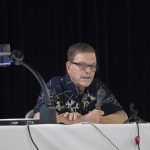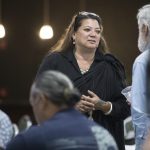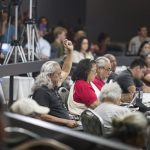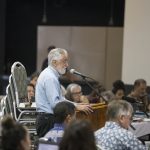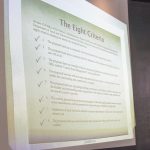After months of preparation and pre-conference hearings, witness testimony for the Thirty Meter Telescope contested case began Thursday in Hilo. ADVERTISING After months of preparation and pre-conference hearings, witness testimony for the Thirty Meter Telescope contested case began Thursday in
After months of preparation and pre-conference hearings, witness testimony for the Thirty Meter Telescope contested case began Thursday in Hilo.
Perry White, principal planner of Planning Solutions Inc., was the first witness brought forth by attorneys representing the University of Hawaii at Hilo and was cross-examined by nine parties over the course of more than 5 hours.
Seven parties in the contested case have yet to cross-examine White and will continue with those proceedings Monday when the hearing resumes.
The sound of conch shells blown by cultural practitioners marked the official 9 a.m. hearing start Thursday, but testimony was delayed more than an hour as hearings officer Riki May Amano, a retired judge, heard complaints from parties regarding notice of the hearing itself, the hearing location and schedule, and access to documents.
About 50 people filled the Crown Room of the Hilo Naniloa Hotel in the morning to watch the hearing, with some leaving after a break for lunch.
The contested case, a quasi-judicial hearing, is the result of a state Supreme Court decision in December 2015 stating that the original permit issued to UH to build the Thirty Meter Telescope on Mauna Kea was not valid because it was issued in violation of TMT opponents’ due process rights.
Opponents sought a contested case in 2011. The state Board of Land and Natural Resources issued a permit for the $1.4 billion project before the original contested case was held.
The 2011 contested case had just six petitioners, as compared to nearly two dozen in the current case (six did not appear for Thursday’s proceedings). Its hearings lasted seven days spread out over two months.
So far, 12 days have been set aside for the current case.
Most parties in the current case are representing themselves, pro se. This led to several occasions of procedural confusion throughout the day, particularly with regard to making objections and what could be considered evidence.
Amano said she would give each party the opportunity to cross-examine each witness and added, “My intention is to pretty much accept every witness via direct (written) testimony.”
White provided a 10-minute summary of his previously submitted written testimony before his cross-examination, explaining how he and two other planners had created the conservation district usage application that was submitted to the state Board of Land and Natural Resources in 2011.
“The purpose of the conservation district is to regulate or manage the district’s use in a responsible way,” White said. “That is why commercial fishing and logging can be permitted (in districts). It is to manage, not prohibit.”
White said he thought the TMT would contribute to the long-term sustainability of Mauna Kea resources, given that the TMT board had committed to a decommission plan for the telescope.
During cross-examination, he reiterated that his statement was based on long-term assessments in light of the fact other telescopes on Mauna Kea also are scheduled to be decommissioned while the TMT is in use.
“The TMT is being developed and implemented in the context of all the other projects,” he said. “When one looks at the whole picture, not just at the one telescope … then one can reach this conclusion.”
Some cross-examination focused on White’s usage of the term TMT International Observatory in his written testimony, as opposed to TMT Observatory Corp. TIO was entered as a new party to the case earlier this year.
Ian Sandison, an attorney for UH, objected on the grounds that it was “common knowledge” that TIO was the successor to the TMT Observatory Corp. and future testimony would address this.
While creating the conservation district usage application, White relied on, among other documents, an environmental impact statement prepared by UH, as the TMT proposing agency, in 2010. The EIS was cited multiple times during cross-examination.
Pua Case, representing the Flores-Case ohana, asked White to describe construction impact to the mountain on a typical day.
“I’m wondering what the temporary impact would be to a cultural practitioner who is there to do ceremonies on the northern plateau … if a practitioner is there chanting and it’s dusty and noisy, would that impact the ceremony?” she said.
Case also asked if White personally considered the mountain sacred, a question objected to and sustained on the grounds it did not relate to White’s written testimony.
Petitioner Harry Fergestrom said he was concerned about excavating rocks at the TMT site because according to Hawaiian cultural practice they are considered kupuna.
Cross-examination by Honolulu attorney Dexter Kaiama, representing original petitioner KAHEA: The Hawaiian Environmental Alliance, lasted just under an hour and a half.
Other parties questioned White on whether the impacts of the telescope project could be mitigated.
Before adjourning the hearing, Amano reiterated that flexibility would be needed throughout the case given the variations in time for testimony, cross-examination and rebuttals.
“The first (day) is always a little bit more difficult because the routine hasn’t been established,” she said.
The contested case hearing resumes at 9 a.m. Monday and will continue through Thursday next week.
